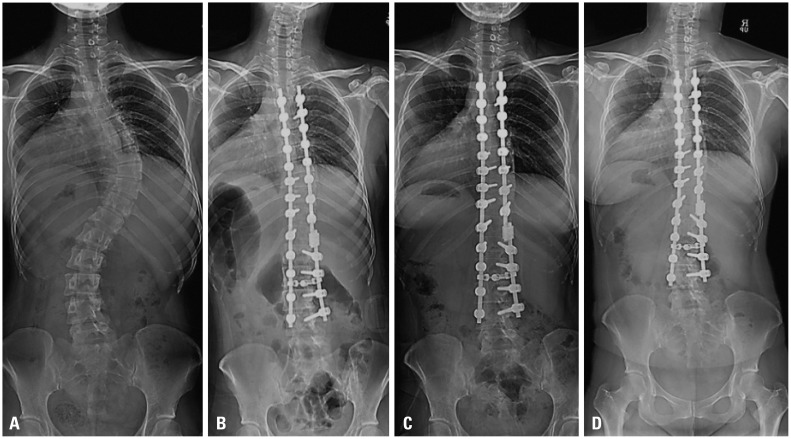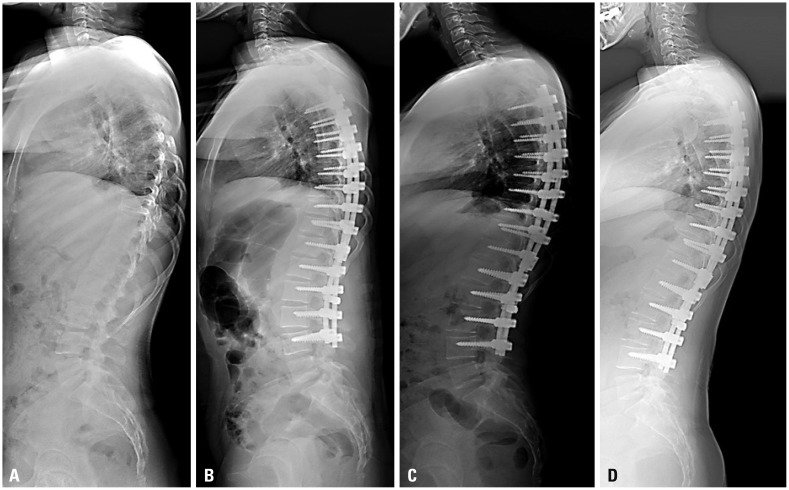Yonsei Med J.
2020 Apr;61(4):323-330. 10.3349/ymj.2020.61.4.323.
Posterior Correction of Adolescent Idiopathic Scoliosis with High-Density Pedicle Screw-Only Constructs: 5 Years of Follow-Up
- Affiliations
-
- 1Scoliosis Center, Asan Medical Center, Ulsan University College of Medicine, Seoul, Korea.
- 2Department of Orthopedic Surgery, Gil Medical Center, Gachon University College of Medicine, Incheon, Korea. bbaik98@gmail.com
- KMID: 2471918
- DOI: http://doi.org/10.3349/ymj.2020.61.4.323
Abstract
- PURPOSE
This study aimed to analyze radiological outcomes in patients with adolescent idiopathic scoliosis (AIS) who underwent posterior correction with high-density pedicle screw-only constructs. We hypothesized that high-density pedicle screw-only constructs in AIS would provide a high correction rate and would facilitate the maintenance of the correction or obviate the loss thereof.
MATERIALS AND METHODS
We retrospectively analyzed radiological outcomes over a minimum follow-up period of 5 years in patients with AIS who underwent posterior correction with high-density pedicle screw-only constructs. A total of 124 consecutive patients were included. Demographic data, including age, sex, operated fusion level, numbers of screw, Lenke curve type, Risser stage, and follow-up period were retrospectively collected from electronic medical records and radiological measurements including serial follow-up.
RESULTS
The average number of pedicle screws was 1.96/vertebra. The average curve correction was 48.3% for the proximal thoracic (PT) curve, 83.1% for the main thoracic (MT) curve, and 80.2% for the thoracolumbar/lumbar (TL/L) curve at final follow-up. Use of high-density pedicle screw-only constructs helped achieve excellent correction rates, with no significant loss of correction at final follow-up.
CONCLUSION
We obtained excellent correction rates of 48.3% for PT, 83.1% for MT, and 80.2% for TL/L curves using high-density pedicle screw-only constructs in AIS, with no significant loss of correction at final follow-up.
MeSH Terms
Figure
Reference
-
1. Kepler CK, Meredith DS, Green DW, Widmann RF. Long-term outcomes after posterior spine fusion for adolescent idiopathic scoliosis. Curr Opin Pediatr. 2012; 24:68–75. PMID: 22157365.
Article2. Suk SI, Lee CK, Kim WJ, Chung YJ, Park YB. Segmental pedicle screw fixation in the treatment of thoracic idiopathic scoliosis. Spine (Phila Pa 1976). 1995; 20:1399–1405. PMID: 7676339.
Article3. Shufflebarger HL, Geck MJ, Clark CE. The posterior approach for lumbar and thoracolumbar adolescent idiopathic scoliosis: posterior shortening and pedicle screws. Spine (Phila Pa 1976). 2004; 29:269–276. PMID: 14752348.
Article4. Hee HT, Yu ZR, Wong HK. Comparison of segmental pedicle screw instrumentation versus anterior instrumentation in adolescent idiopathic thoracolumbar and lumbar scoliosis. Spine (Phila Pa 1976). 2007; 32:1533–1542. PMID: 17572624.
Article5. Li M, Ni J, Fang X, Liu H, Zhu X, He S, et al. Comparison of selective anterior versus posterior screw instrumentation in Lenke5C adolescent idiopathic scoliosis. Spine. 2009; 34:1162–1166. PMID: 19444064.
Article6. Wang Y, Fei Q, Qiu G, Lee CI, Shen J, Zhang J, et al. Anterior spinal fusion versus posterior spinal fusion for moderate lumbar/thoracolumbar adolescent idiopathic scoliosis: a prospective study. Spine (Phila Pa 1976). 2008; 33:2166–2172. PMID: 18794757.7. Papin P, Labelle H, Delorme S, Aubin CE, de Guise JA, Dansereau J. Long-term three-dimensional changes of the spine after posterior spinal instrumentation and fusion in adolescent idiopathic scoliosis. Eur Spine J. 1999; 8:16–21. PMID: 10190849.
Article8. Crawford AH, Lykissas MG, Gao X, Eismann E, Anadio J. All-pedicle screw versus hybrid instrumentation in adolescent idiopathic scoliosis surgery: a comparative radiographical study with a minimum 2-year follow-up. Spine (Phila Pa 1976). 2013; 38:1199–1208. PMID: 23429683.9. Hwang SW, Samdani AF, Marks M, Bastrom T, Garg H, Lonner B, et al. Five-year clinical and radiographic outcomes using pedicle screw only constructs in the treatment of adolescent idiopathic scoliosis. Eur Spine J. 2013; 22:1292–1299. PMID: 23254863.
Article10. Uehara M, Takahashi J, Ikegami S, Oba H, Kuraishi S, Futatsugi T, et al. Determination of optimal screw number based on correction angle for main thoracic curve in adolescent idiopathic scoliosis. J Orthop Sci. 2019; 24:415–419. PMID: 30514594.
Article11. Lenke LG, Betz RR, Clements D, Merola A, Haher T, Lowe T, et al. Curve prevalence of a new classification of operative adolescent idiopathic scoliosis: does classification correlate with treatment? Spine (Phila Pa 1976). 2002; 27:604–611. PMID: 11884908.12. Nash CL Jr, Moe JH. A study of vertebral rotation. J Bone Joint Surg Am. 1969; 51:223–229. PMID: 5767315.
Article13. Lee CS, Kim MJ, Ahn YJ, Kim YT, Jeong KI, Lee DH. Thoracic pedicle screw insertion in scoliosis using posteroanterior C-arm rotation method. J Spinal Disord Tech. 2007; 20:66–71. PMID: 17285055.
Article14. King HA, Moe JH, Bradford DS, Winter RB. The selection of fusion levels in thoracic idiopathic scoliosis. J Bone Joint Surg Am. 1983; 65:1302–1313. PMID: 6654943.
Article15. Lenke LG, Edwards CC 2nd, Bridwell KH. The Lenke classification of adolescent idiopathic scoliosis: how it organizes curve patterns as a template to perform selective fusions of the spine. Spine (Phila Pa 1976). 2003; 28:S199–S207. PMID: 14560193.
Article16. Lee CS, Hwang CJ, Lee DH, Cho JH. Five major controversial issues about fusion level selection in corrective surgery for adolescent idiopathic scoliosis: a narrative review. Spine J. 2017; 17:1033–1044. PMID: 28373082.
Article17. Cochran T, Irstam L, Nachemson A. Long-term anatomic and functional changes in patients with adolescent idiopathic scoliosis treated by Harrington rod fusion. Spine (Phila Pa 1976). 1983; 8:576–584. PMID: 6228016.
Article18. Wood KB, Transfeldt EE, Ogilvie JW, Schendel MJ, Bradford DS. Rotational changes of the vertebral-pelvic axis following Cotrel-Dubousset instrumentation. Spine (Phila Pa 1976). 1991; 16(8 Suppl):S404–S408. PMID: 1785095.
Article19. Suk SI, Kim JH, Kim SS, Lim DJ. Pedicle screw instrumentation in adolescent idiopathic scoliosis (AIS). Eur Spine J. 2012; 21:13–22. PMID: 21874625.
Article20. Suk SI, Lee SM, Chung ER, Kim JH, Kim SS. Selective thoracic fusion with segmental pedicle screw fixation in the treatment of thoracic idiopathic scoliosis: more than 5-year follow-up. Spine (Phila Pa 1976). 2005; 30:1602–1609. PMID: 16025028.21. Kuklo TR, Potter BK, Lenke LG, Polly DW Jr, Sides B, Bridwell KH. Surgical revision rates of hooks versus hybrid versus screws versus combined anteroposterior spinal fusion for adolescent idiopathic scoliosis. Spine (Phila Pa 1976). 2007; 32:2258–2264. PMID: 17873820.
Article22. Samdani AF, Belin EJ, Bennett JT, Pahys JM, Marks MC, Miyanji F, et al. Unplanned return to the operating room in patients with adolescent idiopathic scoliosis: are we doing better with pedicle screws? Spine (Phila Pa 1976). 2013; 38:1842–1847. PMID: 23873241.23. Cheng I, Kim Y, Gupta MC, Bridwell KH, Hurford RK, Lee SS, et al. Apical sublaminar wires versus pedicle screws--which provides better results for surgical correction of adolescent idiopathic scoliosis? Spine (Phila Pa 1976). 2005; 30:2104–2112. PMID: 16166903.
Article24. Vora V, Crawford A, Babekhir N, Boachie-Adjei O, Lenke L, Peskin M, et al. A pedicle screw construct gives an enhanced posterior correction of adolescent idiopathic scoliosis when compared with other constructs: myth or reality. Spine (Phila Pa 1976). 2007; 32:1869–1874. PMID: 17762295.25. Clements DH, Betz RR, Newton PO, Rohmiller M, Marks MC, Bastrom T. Correlation of scoliosis curve correction with the number and type of fixation anchors. Spine (Phila Pa 1976). 2009; 34:2147–2150. PMID: 19752700.
Article26. Hwang CJ, Lee CK, Chang BS, Kim MS, Yeom JS, Choi JM. Minimum 5-year follow-up results of skipped pedicle screw fixation for flexible idiopathic scoliosis. J Neurosurg Spine. 2011; 15:146–150. PMID: 21568649.
Article27. Larson AN, Polly DW Jr, Diamond B, Ledonio C, Richards BS 3rd, Emans JB, et al. Does higher anchor density result in increased curve correction and improved clinical outcomes in adolescent idiopathic scoliosis? Spine (Phila Pa 1976). 2014; 39:571–578. PMID: 24430717.
Article28. Lehman RA Jr, Lenke LG, Keeler KA, Kim YJ, Buchowski JM, Cheh G, et al. Operative treatment of adolescent idiopathic scoliosis with posterior pedicle screw-only constructs: minimum three-year follow-up of one hundred fourteen cases. Spine (Phila Pa 1976). 2008; 33:1598–1604. PMID: 18552676.29. Min K, Sdzuy C, Farshad M. Posterior correction of thoracic adolescent idiopathic scoliosis with pedicle screw instrumentation: results of 48 patients with minimal 10-year follow-up. Eur Spine J. 2013; 22:345–354. PMID: 23064806.
Article30. Uehara M, Takahashi J, Ikegami S, Kuraishi S, Futatsugi T, Oba H, et al. Mid-term results of computer-assisted skip pedicle screw fixation for patients with Lenke type 1 and 2 adolescent idiopathic scoliosis: a minimum five-year follow-up study. J Orthop Sci. 2018; 23:248–252. PMID: 29198598.
Article31. Yu CH, Chen PQ, Ma SC, Pan CH. Segmental correction of adolescent idiopathic scoliosis by all-screw fixation method in adolescents and young adults: minimum 5 years follow-up with SF-36 questionnaire. Scoliosis. 2012; 7:5. PMID: 22340624.
Article32. Lonner BS, Lazar-Antman MA, Sponseller PD, Shah SA, Newton PO, Betz R, et al. Multivariate analysis of factors associated with kyphosis maintenance in adolescent idiopathic scoliosis. Spine (Phila Pa 1976). 2012; 37:1297–1302. PMID: 22228329.
Article33. Liu H, Li Z, Li S, Zhang K, Yang H, Wang J, et al. Main thoracic curve adolescent idiopathic scoliosis: association of higher rod stiffness and concave-side pedicle screw density with improvement in sagittal thoracic kyphosis restoration. J Neurosurg Spine. 2015; 22:259–266. PMID: 25525960.
Article
- Full Text Links
- Actions
-
Cited
- CITED
-
- Close
- Share
- Similar articles
-
- Comparison of Apical Axial Derotation between Adolescent Idiopathic and Neuromuscular Scoliosis with Pedicle Screw Instrumentation
- Posterior Correction with Segmental Pedicle Screw Fixation Alone in Severe Adolescent Idiopathic Scoliosis Over 70 degrees
- Clinical Results of Selective Thoracic Fusion by Segmental Pedicle Screws in King type II Adolescent Idiopathic Scoliosis ( AIS )
- Periapical Wires Result in Less Curve Correction Than Pedicle Screw Constructs in Idiopathic Scoliosis
- Segmental pedicle screw fixation in the treatment of Thoracic idiopathic scoliosis



